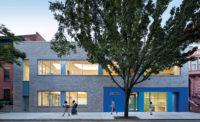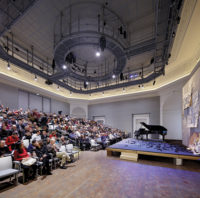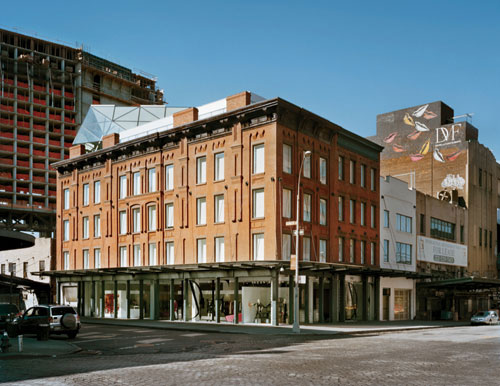Diane von Furstenberg Studio Headquarters
Work Architecture Company injects daylight and panache into a 19th-century warehouse in New York City's Meatpacking District.

Photo © Elizabeth Felicella

Photo © Elizabeth Felicella

Photo © Elizabeth Felicella

Photo © Elizabeth Felicella

Photo © Elizabeth Felicella

Photo © Elizabeth Felicella

Photo © Elizabeth Felicella

Photo © Elizabeth Felicella

Photo © Elizabeth Felicella

Photo © Elizabeth Felicella

Image courtesy WORKac

Image courtesy WORKac

Image courtesy WORKac

Image courtesy WORKac

Image courtesy WORKac















Architects & Firms
At a fund-raiser held recently at the Diane von Furstenberg Studio Headquarters in New York City, a guest, Hugh Hardy, FAIA, ebulliantly broke out into a Gershwin tune, “I’ll build a stairway to paradise, with a new step every day.” Prompted by the expansive white stair slicing diagonally through the 19th-century warehouse that Work Architecture Company (WORKac) renovated for the fashion designer, Hardy’s showbiz homage was befiting. With its concrete treads and risers, and edged by stainless-steel cables, the grand stair funnels daylight from an oddly angular yet bulbous rooftop skylight throughout five floors of the work and display spaces. (A sixth floor, atop the roof, accommodates a glassed-in penthouse apartment.)
Basically, von Furstenberg wanted to bring together her business’s activities in one building that would include a flagship store on the street level, a 5,000-square-foot showroom and event area, along with office space for 120, plus her own office and living quarters. Additional functions, such as storage rooms, a silk-screening workshop, and additional dressing rooms for the shop, could be contained in the large basement. Because the warehouse is located in the Gansevoort Market Historic District, the renovation, including the “diamond,” as the architects call the protruding skylight, had to get past the Landmarks Preservation Commission. Since this was the first renovation in this landmark district on Manhattan’s West Side, the architects needed to present the rooftop protuberance to a group that felt “invisible” best describes any kind of physical change to a building’s exterior. “We argued this would announce that there was new life in the district,” explains WORKac’s principal Dan Wood, AIA. Although retail stores were swiftly moving into the area, many buildings were still boarded up. The young architect and his partner, Amale Andraos [record, December 2006, page 116], won over Landmarks, and proceeded with a sensitive restoration of the two most visible facades of the old structure. Nevertheless, steel, aluminum, and glass elements of new construction insouciantly reveal themselves from the rooftop and from the rear.
In addition to repointing the brick of the 19th-century warehouse, the architects sealed the existing copper cornice, repaired rust spots, painted the cast-iron columns, and installed new plate-glass windows. To satisfy the desire of the preservationists to retain the deep metal street canopies girding the district’s buildings, WORKac designed a new canopy to jut over the north and east sidewalks of the corner site. The firm desired a translucent canopy rather than the corrugated metal ones more common to the district: By luck, it found corrugated wired glass from the Philadelphia Navy Yard to successfully recycle.
Inside the brick enclosure, WORKac installed a new structure of steel columns with metal-and-concrete decking and poured resin floors. The central stair, formed of precast-concrete sections, not only acts as the circulation device and light shaft, but reveals the different activities organized around the core—from the lobby to the second-floor showroom, as well as the offices and design workshops above, plus von Furstenberg’s own offices and living quarters. (A private stair leads to the penthouse.) Helping admit daylight to the stair and throughout the interior is the deformed, angular glass-and-steel structure popping out of the roof. None of the milled elements of this geodelike structure, engineered and built in Spain, are alike.
PeopleOwner Architect Principals: Amale Andraos, Dan Wood, AIA Project architects: Silvia Fuster, Eckart Graeve, Engineers: Mechanical, main building: Athwal Associates Mechanical, penthouse: Syska Hennessy Consultants Lighting: Tillotson Design Associates Acoustical: Arup Acoustics Landmarks: Higgins & Quasebarth Curtain wall: Front Inc. Heliostat mirrors: Bomin Solar Geothermal: CGD Water Energy Distributors Photographer: Elizabeth Felicella |
ProductsStructural System: Velux Glass storefront: Empire Glass Glass crystals: Swarovski Precast-concrete stair: Bethlehem Precast Acoustical ceilings: Hunter Douglas Steel: Optimum Window Manufacturing
|

















